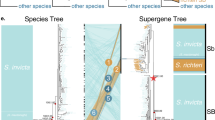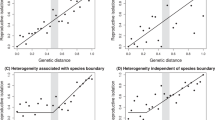Abstract
Understanding speciation is a fundamental biological problem. It is believed that many species originated through allopatric divergence, where new species arise from geographically isolated populations of the same ancestral species1,2,3. In contrast, the possibility of sympatric speciation (in which new species arise without geographical isolation) has often been dismissed, partly because of theoretical difficulties2,3. Most previous models analysing sympatric speciation concentrated on particular aspects of the problem while neglecting others4,5,6,7,8,9,10. Here we present a model that integrates a novel combination of different features and show that sympatric speciation is a likely outcome of competition for resources. We use multilocus genetics to describe sexual reproduction in an individual-based model, and we consider the evolution of assortative mating (where individuals mate preferentially with like individuals) depending either on an ecological character affecting resource use or on a selectively neutral marker trait. In both cases, evolution of assortative mating often leads to reproductive isolation between ecologically diverging subpopulations. When assortative mating depends on a marker trait, and is therefore not directly linked to resource competition, speciation occurs when genetic drift breaks the linkage equilibrium between the marker and the ecological trait. Our theory conforms well with mounting empirical evidence for the sympatric origin of many species10,11,12,13,14,15,16,17,18.
This is a preview of subscription content, access via your institution
Access options
Subscribe to this journal
Receive 51 print issues and online access
$199.00 per year
only $3.90 per issue
Buy this article
- Purchase on Springer Link
- Instant access to full article PDF
Prices may be subject to local taxes which are calculated during checkout





Similar content being viewed by others
References
Mayr, E. Animal Species and Evolution (Harvard Univ. Press, Cambridge, Massachusetts, 1963).
Coyne, J. A. Genetics and speciation. Nature 355, 511 –515 (1992).
Rice, W. R. & Hostert, E. E. Laboratory experiments on speciation — what have we learned in 40 years. Evolution 47, 1637–1653 (1993).
Maynard Smith, J. Sympatric speciation. Am. Nat. 100, 637– 650 (1966).
Rosenzweig, M. L. Competitive speciation. Biol. J. Linn. Soc. (Lond.) 10, 275–289 (1978).
Felsenstein, J. Skepticism towards Santa Rosalia, or why are there so few kinds of animals? Evolution 35, 124–138 (1981).
Seger, J. in Evolution. Essays in Honour of John Maynard Smith (eds Greenwood, P. J., Harvey, P. H. & Slatkin, M.) (Cambridge Univ. Press, Cambridge, 1985).
Kondrashov, A. S. Multilocus model of sympatric speciation III. computer simulations. Theor. Pop. Biol. 29, 1–15 (1986).
Johnson, P. A., Hoppenstaedt, F. C., Smith, J. J. & Bush, G. L. Conditions for sympatric speciation: a diploid model incorporating habitat fidelity and non-habit assortative mating. Evol. Ecol. 10, 187–205 (1996).
Bush, G. L. Sympatric speciation in animals — new wine in old bottles. Trends Ecol. Evol. 9, 285–288 (1994).
Meyer, A., Kocher, T. D., Basasibwaki, P. & Wilson, A. C. Monophyletic origin of Lake Victoria cichlid fishes suggested by mitochondrial DNA sequences. Nature 347, 550– 553 (1990).
Schliewen, U. K., Tautz, D. & Pääbo, S. Sympatric speciation suggested by monophyly of crater lake cichlids. Nature 368, 629– 623 (1994).
Schluter, D. Experimental evidence that competition promotes divergence in adaptive radiation. Science 266, 798–801 (1994).
Johannesson, K., Rolan-Alvarez, E. & Ekendahl, A. Incipient reproductive isolation between two sympatric morphs of the intertidal snail Littorina saxatilis. Evolution 49, 1180–1190 ( 1995).
Knox, E. B. & Palmer, J. D. Chloroplast DNA variation and the recent radiation of giant senecios (Asteraceae) on the tall mountains of Eastern Africa. Proc. Natl Acad. Sci. USA 92, 10349–10353 (1995).
Taylor, E. B. & McPhail, J. D. Evolutionary history of an adaptive radiation in species pairs of threespine sticklebacks (Gasterosteus): insights from mitochondrial DNA. Biol. J. Linn. Soc. 66, 271–291 (1999).
Losos, J. B., Jackman, T. R., Larson, A., de Queiroz, K. & Rodríguez-Schettino, L. Contingency and determinism in replicated adaptive radiations of island lizards. Science 279, 2115–2118 ( 1998).
Orr, M. R. & Smith, T. B. Ecology and speciation. Trends Ecol. Evol. 13, 502–506 (1998).
Metz, J. A. J., Geritz, S. A. H., Meszéna, G., Jacobs, F. J. A. & van Heerwaarden, J. S. in Stochastic and Spatial Structures of Dynamical Systems (eds van Strien, S. J. & Verduyn Lunel, S. M. ) 183–231 (North Holland, Amsterdam, 1996).
Dieckmann, U. & Law, R. The dynamical theory of coevolution: a derivation from stochastic ecological processes. J. Math. Biol. 34, 579–612 ( 1996).
Dieckmann, U. Can adaptive dynamics invade? Trends Ecol. Evol. 12 , 128–131 (1997).
Geritz, S. A. H., Kisdi, E., Meszéna, G. & Metz, J. A. J. Evolutionarily singular strategies and the adaptive growth and branching of the evolutionary tree. Evol. Ecol. 12, 35 –57 (1998).
Doebeli, M. & Ruxton, G. D. Evolution of dispersal rates in metapopulation models: branching and cyclic dynamics in phenotype space. Evolution 51, 1730–1741 (1997).
Doebeli, M. Aquantitative genetic competition model for sympatric speciation. J. Evol. Biol. 9, 893–909 (1996).
Turner, G. F. & Burrows, M. T. Amodel of sympatric speciation by sexual selection. Proc. R. Soc. Lond. B 260, 287–292 (1995).
Kondrashov, A. S. & Shpak, M. On the origin of species by means of assortative mating. Proc. R. Soc. Lond. B 265, 2273–2278 (1998).
Schluter, D. & McPhail, J. D. Character displacement and replicate adaptive radiation. Trends Ecol. Evol. 8, 197–200 (1993).
Schluter, D. & Nagel, L. M. Parallel speciation by natural selection. Am. Nat. 146, 292– 301 (1995).
Nagel, L. M. & Schluter, D. Body size, natural selection, and speciation in sticklebacks. Evolution 52, 209–218 (1998).
Seehausen, O., van Alphen, J. J. M. & Witte, F. Cichlid fish diversity threatened by eutrophication that curbs sexual selection. Science 277, 1808–1811 (1997).
Acknowledgements
We thank H. Metz, R. Law, M. Heino, S. Stearns, J. Maynard Smith and N. Knowlton for helpful comments, and U. Schliewen, K. Rasmussen and D. Tautz for discussions. The order of authors is alphabetical.
Author information
Authors and Affiliations
Corresponding author
Rights and permissions
About this article
Cite this article
Dieckmann, U., Doebeli, M. On the origin of species by sympatric speciation. Nature 400, 354–357 (1999). https://doi.org/10.1038/22521
Received:
Accepted:
Issue Date:
DOI: https://doi.org/10.1038/22521
This article is cited by
-
Competition-driven eco-evolutionary feedback reshapes bacteriophage lambda’s fitness landscape and enables speciation
Nature Communications (2024)
-
Ecological disruptive selection acting on quantitative loci can drive sympatric speciation
npj Systems Biology and Applications (2024)
-
Ecological determinants of Cope’s rule and its inverse
Communications Biology (2024)
-
Mito-nuclear selection induces a trade-off between species ecological dominance and evolutionary lifespan
Nature Ecology & Evolution (2022)
-
Path probability selection in nature and path integral
Scientific Reports (2022)
Comments
By submitting a comment you agree to abide by our Terms and Community Guidelines. If you find something abusive or that does not comply with our terms or guidelines please flag it as inappropriate.



